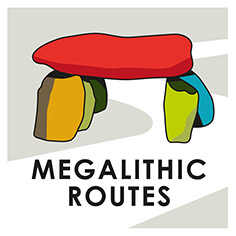Long barrows and stone circles in southern England
Megalithic monuments in Britain are mainly concentrated in western and northern areas where sources of suitable stone were widely available. In the south and east of the country comparable monuments were mainly built of wood. Many different styles exist, some reflecting local traditions while others illustrate changing preferences over time. Strong connections can be seen in the design of the monuments with structures south-westwards along the Atlantic seaways in Ireland, France, Spain, and Portugal, and eastwards towards southern Scandinavia, northern Germany, and the Netherlands.
Southwest England contains a range of easily accessible and impressive megalithic monuments that can be visited through two connected trails, both starting within the Stonehenge and Avebury World Heritage Site, Wiltshire.
The first illustrates a selection of long barrows built in the Cotswold-Severn tradition between about 3800 BC and 3300 BC. Rectangular mounds of earth and stone up to 100m long contain chambers variously set at the end of the mound or along the sides. Excavations have revealed disarticulated human remains representing men, women and children of all ages on the floors of the chambers, the result of complicated mortuary rituals. Starting at West Kennet long barrow immediately south of Avebury this circular route takes in Stoney Littleton (Somerset), Hetty Pegler’s Tump (Gloucestershire), Nympsfield (Gloucestershire), Rodmarton (Gloucestershire), Belas Knap (Gloucestershire), Notgrove (Gloucestershire) and Wayland’s Smithy (Oxfordshire) before returning to the archaeologically rich landscape of Avebury.
The second part of the route focuses on the great stone circles and henges of southwest England, structures built relatively late in the overall sequence of European megaliths between 3000 BC and 2000 BC. Avebury itself contains the largest stone circle in Britain, 98 pillars in a ring 332m across. From Avebury the route goes south to Stonehenge, Wiltshire, unique in having a central horseshoe setting of five great sarsen trilithons surrounded by a ring of 30 sarsen uprights linked at the top by carefully shaped stone lintels. Within this structure are the remains of around 80 smaller so-called ‘bluestones’ that were brought to the site from the Preseli Mountains of southwest Wales, a distance of more than 220km as the crow flies. Continuing westwards are a selection of circles in impressive landscape settings: a cluster of three at Stanton Drew (Somerset), single rings at Withypool (Devon), Grey Wethers (Devon) and Merrivale (Devon), a group of four circles at the Hurlers (Cornwall), and a single picturesque ring at Merry Maidens (Cornwall) not far from Land’s End and the westernmost tip of England.
Jersey
Jersey is the largest of the Channel Islands, a self-governing Crown dependency lying just 22 km west of the French coast. Given its strategic position, the island has been a site for settlement since prehistory, with past populations leaving their traces on the archaeological landscape. One of these extraordinary traditions is that of megalithic, dating from c. 4500-2250 BC, and of which many structures still survive today. Jersey´s dolmens were celebratory monuments made of huge slabs of granite, where People would gather to celebrate the changing of the seasons, the harvests and to honour and bury their dead. The dolmens were originally covered with great mounds of earth, and subsequent generations of farmers would try in vain to plough them flat, only to find at their center was a giant construction of granite boulders, They were also avoided by superstitious people, as it was thought the dolmens were places of witches and fairies gathered, ready to cause mischief and bad luck to anyone who disturbed them.
Our dolmens are now protected and celebrated as sites of great archaeological importance and are visited by people from all over the world.
As an institution the Société Jersiaise is the owner of the dolmen sites in Jersey and has formed a working group for the membership of megalithic Routes e. V. together with representation from Jersey Heritage and the States of Jersey Department of Economic development, Tourism, Sport and Culture.
Für mehr Informationen:



